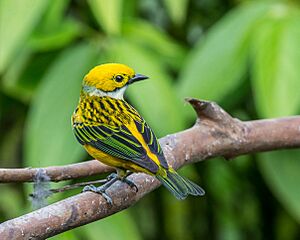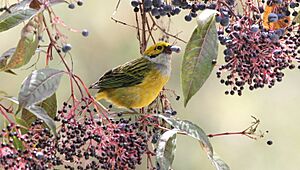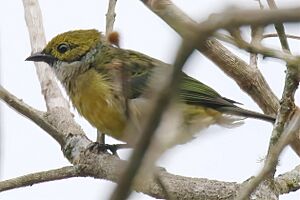Silver-throated tanager facts for kids
Quick facts for kids Silver-throated tanager |
|
|---|---|
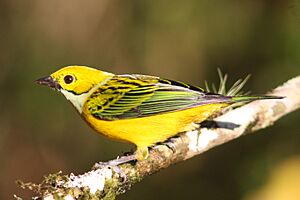 |
|
| T. i. frantzii, Costa Rica | |
| Conservation status | |
| Scientific classification | |
| Genus: |
Tangara
|
| Species: |
icterocephala
|
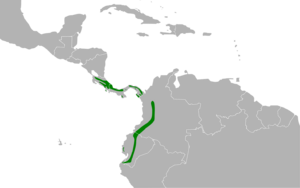 |
|
| Silver-throated tanager range | |
The silver-throated tanager (Tangara icterocephala) is a beautiful, small bird. It belongs to the family of tanagers, called Thraupidae. You can find this bird in countries like Costa Rica, Panama, Colombia, Ecuador, and parts of Peru.
These birds live in different kinds of forests, including mossy forests, mountain forests, and lowland forests. They also like the edges of forests and areas where trees are growing back. The silver-throated tanager is about 13 centimetres (5.1 in) long and weighs around 22 grams (0.78 oz). Males and females look a little different, with females being less bright. Adult males are mostly bright yellow. They have a special silvery-white throat with a black stripe on their cheeks. Their backs have black streaks, and their wings and tail have green edges. Young birds are duller and greener.
Silver-throated tanagers eat both fruits and insects. They usually have two groups of babies, called broods, between April and September. The female builds a cup-shaped nest from moss, leaves, and spider webs. She lays two eggs and takes care of them. The baby birds leave the nest when they are about 15 days old. The International Union for Conservation of Nature (IUCN) says this bird is of "least concern," meaning it's not in immediate danger. However, their homes are being lost because of habitat destruction.
Contents
About the Silver-throated Tanager's Name
The silver-throated tanager was first described in 1851 by Charles Lucien Bonaparte. He gave it the name Calliste icterocephala. Over time, its scientific name changed to Tangara icterocephala.
The name Tangara comes from a word in the Tupi language that means "dancer." The second part of its name, icterocephala, comes from old Greek words. Ikteros means "yellow," and kephalos means "headed." So, its name basically means "yellow-headed dancer"! The official common name, silver-throated tanager, was chosen by the International Ornithologists' Union.
This bird is one of 27 different species in the Tangara group. Scientists have studied its mitochondrial DNA to understand how it's related to other tanagers. The silver-throated tanager is closely related to the emerald tanager.
Different Types of Silver-throated Tanagers
There are three different types, or subspecies, of the silver-throated tanager. They look a bit different and live in slightly different places.
- T. i. frantzii (described in 1861): This type lives from northern Costa Rica down to parts of Panama. It has a bright yellow head and neck. Its throat is lighter than the other types.
- T. i. oresbia (described in 1962): You can find this type in the mountains of Coclé and Panamá Province in Panama. It's the darkest of the three types. Females of this type have dark green edges on their back feathers, which is different from the yellow seen in other types.
- T. i. icterocephala (described in 1851): This is the original type. It lives in the mountains of eastern Darién, Panama, and the Andes mountains in Colombia, western Ecuador, and northeastern Peru.
What the Silver-throated Tanager Looks Like
The silver-throated tanager is a medium-sized tanager. It's about 13 centimetres (5.1 in) long and weighs around 22 grams (0.78 oz). Males and females are a little different in their looks. Females are not as bright as males.
Male birds are mostly bright yellow. They have a shiny, silvery-white throat with a black stripe on their cheeks. Their backs are yellow with black stripes, and their wings and tail are yellow with green edges. Their eyes are brown, their beak is black, and their feet are gray.
Female birds look similar to males but are duller and greener. Sometimes, they have faint dark spots on their heads. Young birds are much duller and greener. Their wings, tail, back stripes, and cheek stripes are dark. Their throat is gray, and their wing edges are a darker green. They keep this duller look until their first breeding season ends.
How They Sound
The calls of the silver-throated tanager sound like buzzing insects. When they are looking for food or flying, they make a harsh, buzzy sound like "jjeut" or a high-pitched "bzeeet." They also make a high-pitched "tic" sound. Scientists haven't fully described their songs yet.
Where They Live and Their Home
You can find the silver-throated tanager from northern Costa Rica, through Panama, Colombia, and Peru, all the way to southern Ecuador. They mostly live in places that are 600–1,800 m (2,000–5,900 ft) high, but sometimes they can be found from 0–2,300 m (0–7,546 ft).
They live in different kinds of forests, like mossy forests, mountain evergreen forests, and tropical lowland evergreen forests. They also like the edges of forests and tall secondary forests (forests that have grown back after being cut down). They can also live in areas that have been changed by humans, as long as there are still some trees and forest left. In Costa Rica, they have been seen in open areas with fruit trees next to forests. However, in Colombia, they usually stay inside the forest.
How Silver-throated Tanagers Behave
Silver-throated tanagers often look for food in pairs or small groups. They might also join larger groups of different bird species, called mixed-species feeding flocks. These flocks can have 3 to 5 silver-throated tanagers, and up to 12 birds when they are with other tanagers, vireos, and wood warblers. Mated pairs stay together all year, but they might spend less time together after the breeding season ends in November or December. These birds have also been seen bathing in water that collects in places like hollows in tree branches.
What They Eat
Silver-throated tanagers are omnivorous, which means they eat both plants and animals. They mainly eat fruits, especially those from plants called melastomes, like Miconia. They have also been seen eating fruits from Souroubea guianensis. During the breeding season, they eat more insects and other small creatures, called arthropods.
They usually look for food in the top parts of trees, called the canopy. They often perch on branches or hang upside down to eat small fruits. In Colombia, they usually look for food in the tops of trees and bushes, about 8.5 m (28 ft) high, and rarely below 3 m (9.8 ft). But in Costa Rica, they look for food closer to the ground. When they hunt for insects, they search on thin, moss-covered branches. They move quickly from branch to branch, sprinting along them while looking for insects. They also pick insects off small branches, a behavior called gleaning.
Reproduction and Life Cycle
In Costa Rica, silver-throated tanagers have babies from April to September. During this time, they usually raise two groups of young, called broods. The female starts building the nest in April. She is the only one who builds it, but the male brings her food and materials for the nest.
Nests are usually built in forests, at heights of 1.8–10.7 m (5.9–35.1 ft). Sometimes, they build nests in single trees. The nests are shaped like a cup and are made of moss and leaves, held together with spider webs. They are often hidden among mossy branches.
The female lays two eggs on two days in a row. The eggs are off-white to dull gray with brown spots, especially at the wider end. They measure about 21.3–15.6 mm (0.84–0.61 in). Only the female sits on the eggs to keep them warm. Both parents feed the young birds. The baby birds, called nestlings, leave the nest after about 15 days, when they are old enough to take care of themselves. On average, about 54.3% of nests and 44.7% of eggs are successful.
Conservation Status
The silver-throated tanager is listed as a species of least concern by the International Union for Conservation of Nature (IUCN) on the IUCN Red List. This means that it has a large area where it lives, and its population is not decreasing quickly.
However, the number of these birds is going down because their homes are being destroyed. This is called habitat destruction. If more trees are planted near open farming areas, it might help the population of these birds grow.



